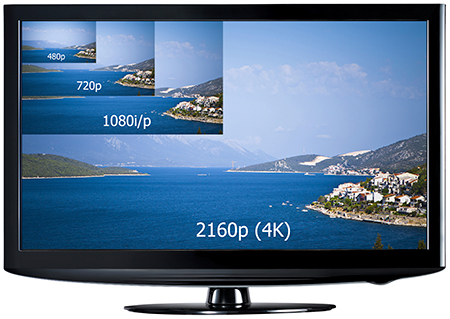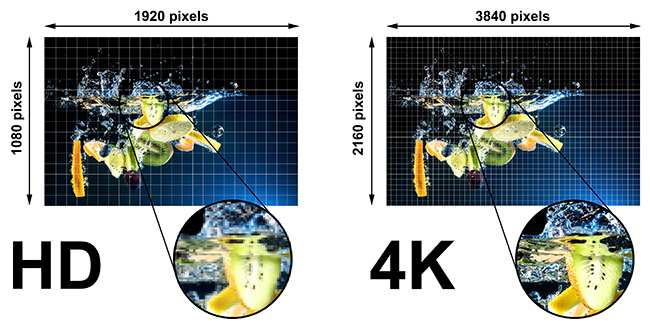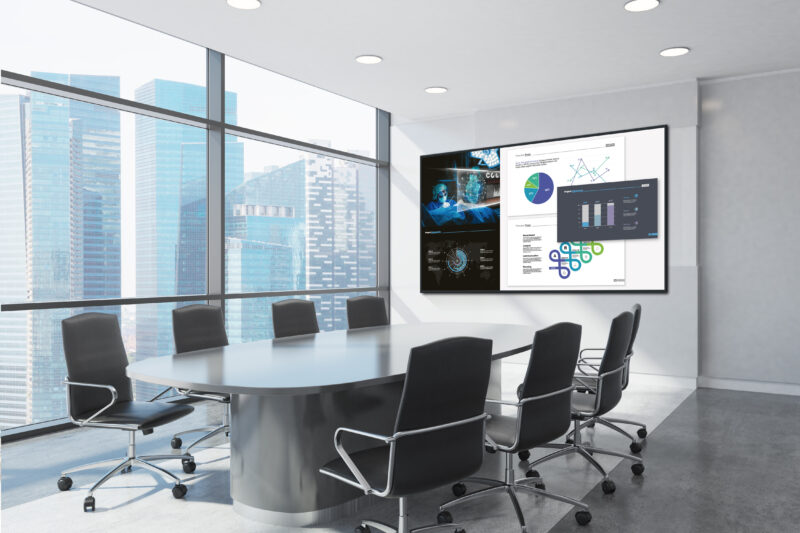What Does 4K Mean to Digital Signage?
By Eran Sharon
Vice President, Product Management, YCD Multimedia
 One of my takeaways from attending trade shows this year is that 4K displays have gone mainstream, mainly because they do 1080p so well.
One of my takeaways from attending trade shows this year is that 4K displays have gone mainstream, mainly because they do 1080p so well.
Before legions of display manufacturers and early adopters start Googling for my address, I’d like to explain that — as many already know — 4K displays offer great opportunities in visual clarity, but place equal challenges on the ecosystem surrounding them — from content production, through playback/rendering, to actually getting the 4K signal to displays.
History
4K, the “little brother” of NHK’s (Japan National Television Network) “Super Hi-Vision” or “8K UHD,” was presented to the public in 2004. In its TV form it offers four times the pixels of 1080p, higher frame rates (up to 120p), and the possibility of improved color spectrum (as suggested by ITU).
At that time, the only way to display the content captured by those cameras was by seaming (welding) together LCD panels, giving birth to the 4K display… Super Hi Vision is still promoted as the future of TV broadcast, with 4K considered an intermediate step.
In addition to the higher resolution, the ITU (International Communication Union) recommended using higher frame rates (up to 120p) and an improved 10-bit color spectrum (billions of colors).
In recent years, display manufacturers have been promoting and selling 4K capable displays to consumers. These technologies are now beginning to propagate into other platforms including commercial/digital signage displays. As a result, 4K-capable players and 4K capabilities are being requested from customers, digital signage providers and owners.
Current Situation
Today, retailers, corporations, educational/health institutions, and transportation hub operators looking to deploy a signage network are all interested in the 4K opportunity but as many know (or find out), there is more to “4K” than pixel counts on a display. One needs to generate and distribute 4K content — preferably at 60 frames/second and high color depth, through compatible signal distribution & cabling to (of course) a display that is optimized for or at least supports the format. Getting THAT to happen can sometimes be more complicated than it appears…
Connectivity
Display manufacturers already offer 4K displays but most still rely on HDMI 1.4 to receive 4K at 30 frames per second (“2160p/30” or “4K/30”). This taxes motion, especially in larger displays and videowalls showing fast moving content.

Distribution and extension of 4K/60fps is still in its infancy
Commercially viable signal distribution is finally catching up and is in many ways still limited to 30Hz and 4:2:0 color encoding, further challenging early adopters. For example: to display 4K/60p on a video wall located away from the players, you either need DisplayPort, HDMI 2.0, four HDMI 1.4 (each transmitting a quarter of the image), or an expensive routing and distribution system. Recent and upcoming IP and point-to-point offerings are finally catching up but rely on modern network and cabling infrastructure.
Content
- Perhaps the greatest challenge which causes many 4K installations to never see 4K content, is worth elaborating on:
- HD broadcasting systems are limited to 1080i (half the row count of 1080p). As a result, even though 4K, 6K (and soon 8K) cameras become available the production tools, editing software, and hardware don’t support 4K or at best support 4K/30. Additionally, most set top boxes in viewers’ homes can only support 1080i or 1080p and replacing those can be a costly endeavor.
- Uncompressed 4K occupies roughly four times the storage. A suitable end-to-end 4K production pipeline requires greater resources and might produce content more slowly, thus increasing costs.
- New codecs optimized for 4K are CPU intensive and thus may not be compatible with older playback hardware.
The Upside of 4K
At this point some readers might be thinking, “If this is so difficult, why bother? Are there any benefits to using 4K in digital signage?” Yes, if one looks at the enhancements 4K technology offers, there are benefits to taking the 4K path:
- Enhanced resolution — with displays reaching 110, 1080p can no longer be relied upon for up close viewing but 4K makes it easy to display and examine fine content on these large displays, making reviewing documents, drawings and other “fine print” in collaborative or teaching environments a reality.
- Smaller A/V “footprint” — as signal distribution and extension options become available, a single cable can replace what previously required four cables. This can significantly reduce cabling and signal distribution costs for large video walls, “clean up” equipment racks and speed up installation. Couple that with reduction in the number of “appliance” type players needed to drive videowalls (one player can drive a 2x2x1080p display array), the resulting smaller racks and lower power consumption and voila! — Things start looking up for those deploying high-resolution videowalls. (Caveat emptor: As of today getting more than three or four 4K outputs from a single player still challenges most players’ processing power.)
- Lower bandwidth requirement – codecs optimized for 4K can reduce file sizes by 60 percent (compared with 4x1080p encoded in H.264), which in turn reduces the bandwidth needed to distribute those files — a major benefit for digital signage networks with multiple high-resolution videowalls.
The above are just a few of the benefits to opting for a 4K digital signage solution. We welcome readers to suggest both challenges and opportunities/benefits to implementing 4K in the digital signage space.
 Author Eran Sharon will be a panelist on the Digital Signage Federation’s August “Hangout” discussion entitled, “What Does 4K Mean to Digital Signage,” on August 26 at 2 p.m. EDT. More information on this and other DSF events can be found on the DSF website. Both DSF members and non-members may join this or any of the DSF’s scheduled Hangout conversations for free – but registration is required and can be accessed on the DSF website here.
Author Eran Sharon will be a panelist on the Digital Signage Federation’s August “Hangout” discussion entitled, “What Does 4K Mean to Digital Signage,” on August 26 at 2 p.m. EDT. More information on this and other DSF events can be found on the DSF website. Both DSF members and non-members may join this or any of the DSF’s scheduled Hangout conversations for free – but registration is required and can be accessed on the DSF website here.
For the past 15 years, Eran Sharon, Vice President, Product Management, YCD Multimedia has worked in technical and executive capacities both in the US and Israel bringing extensive and diverse experience designing, implementing and supervising the execution of audiovisual and media technology systems for various markets including experiential/luxury retail, luxury hospitality, museum, and broadcast. Eran comes to YCD after six years at Audio Video & Controls (AV&C), a New York City based boutique AV design firm where Eran’s work was characterized by successful application of emerging technologies in conjunction with AV best practices to deliver complex projects in these markets.





